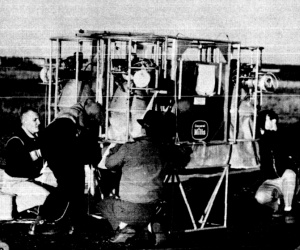Purpose of the flight and payload description
On May 11th, 1963 a probe was launched from New Brighton, Minnesota. The samplers rose to 89,000 ft., the dust covers were jettisoned, and the balloon started a slow descent. At 87,000 ft., Samplers 1 and 2 were activated. Sampler 1 (float control) operated for the initial 4 minutes and aspirated about 5,000 cu ft of the highest level air before terminating. Sampler 2 continued to sample (90,00 cu ft) during descent to 65,000 ft where it teminated. Sampler 3 started at 65,000 ft and aspirated 30,000 cu ft between that altitude and 45,000 ft. Sampler 4 was an sterile control. It was treated the same way as all other units (assemble, autoclave, attach to gondola, store in ethylene-oxide protected only by dust-cover system). Immediately prior to launch, its gates were closed and automatically locked. This unit went through the whole flight sequence in the locked position.
The payload was air borne for 6 hours and impacted without damage in a fallow field near Black River Falls, Wisconsin. Upon examination, there was some doubt about the automatic locking of the anticontamination gates on Samplers l, 2 and 3. Environmental samples of air, grass, and soil were taken from launch and impact sites for subsequent bacteriological analyses.
Details of the balloon flight
Balloon launched on: 5/11/1963
Launch site: University of Minnesota Airport, New Brighton, US
Balloon launched by: General Mills Inc.
Balloon manufacturer/size/composition: Zero Pressure Balloon 960.000 cuft (2 mil)
End of flight (L for landing time, W for last contact, otherwise termination time): 5/11/1963
Balloon flight duration (F: time at float only, otherwise total flight time in d:days / h:hours or m:minutes - ): ~6 h
Payload weight: 821 PDS
External references
- Exploration of the stratosphere for viable microorganisms COSPAR 4th International Space Science Symposium - Biological Symposium - Terrestrial Life in Space, Warsaw, Poland (1963)
- Microbiological exploration of stratosphere. Results of six experimental flights Proceedings of the Atmospheric Biology Conference, Minnesota University, 1964, p. 199
- Research to determine the existence and identify of viable micoorganisms in the stratosphere 1st quarterly status report, mar. 18 - jun. 18 1963
- The Flight Record Scientific Ballooning Nº 10, July 1963
2464If you consider this website interesting or useful, you can help me to keep it up and running with a small donation to cover the operational costs. Just the equivalent of the price of a cup of coffee helps a lot.


